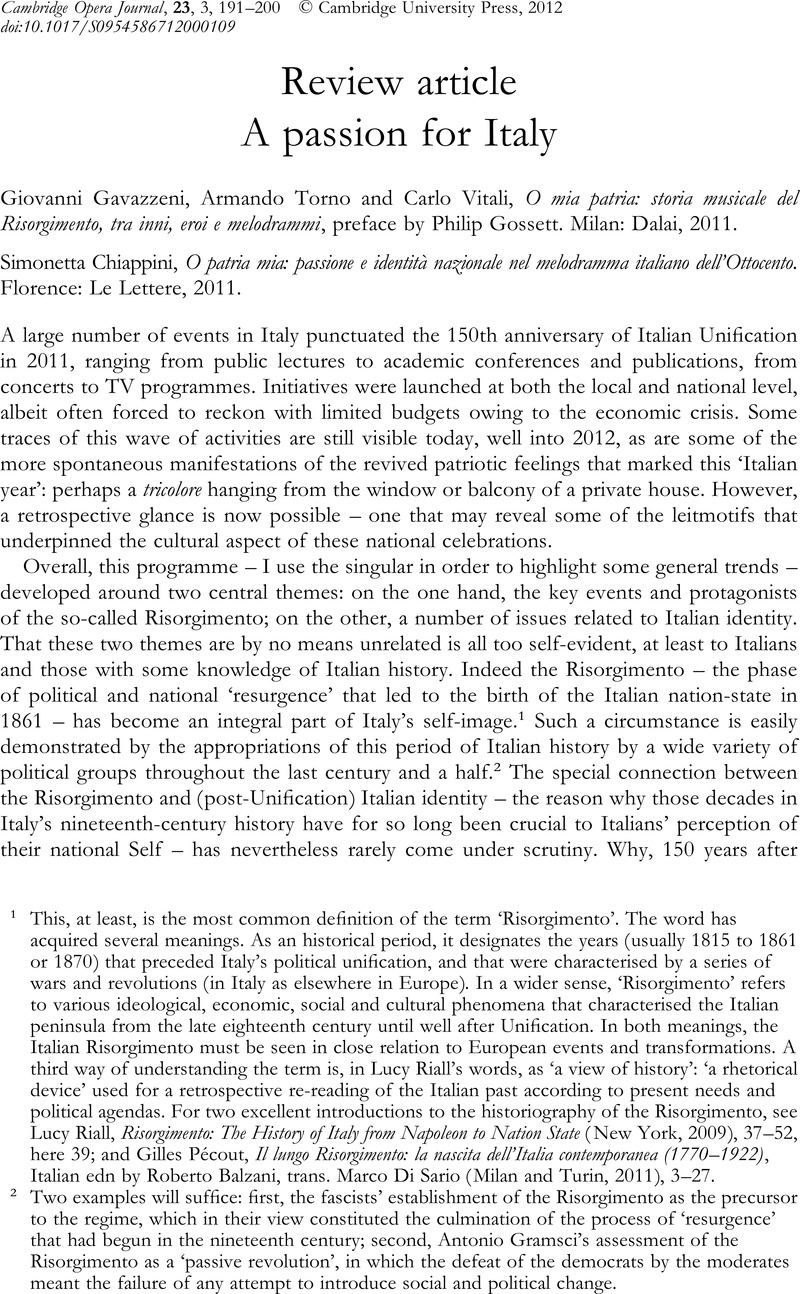No CrossRef data available.
Published online by Cambridge University Press: 17 July 2012

1 This, at least, is the most common definition of the term ‘Risorgimento’. The word has acquired several meanings. As an historical period, it designates the years (usually 1815 to 1861 or 1870) that preceded Italy's political unification, and that were characterised by a series of wars and revolutions (in Italy as elsewhere in Europe). In a wider sense, ‘Risorgimento’ refers to various ideological, economic, social and cultural phenomena that characterised the Italian peninsula from the late eighteenth century until well after Unification. In both meanings, the Italian Risorgimento must be seen in close relation to European events and transformations. A third way of understanding the term is, in Lucy Riall's words, as ‘a view of history’: ‘a rhetorical device’ used for a retrospective re-reading of the Italian past according to present needs and political agendas. For two excellent introductions to the historiography of the Risorgimento, see Riall, Lucy, Risorgimento: The History of Italy from Napoleon to Nation State (New York, 2009), 37–52, here 39CrossRefGoogle Scholar; and Pécout, Gilles, Il lungo Risorgimento: la nascita dell'Italia contemporanea (1770–1922), Italian edn by Balzani, Roberto, trans. Di Sario, Marco (Milan and Turin, 2011), 3–27Google Scholar.
2 Two examples will suffice: first, the fascists' establishment of the Risorgimento as the precursor to the regime, which in their view constituted the culmination of the process of ‘resurgence’ that had begun in the nineteenth century; second, Antonio Gramsci's assessment of the Risorgimento as a ‘passive revolution’, in which the defeat of the democrats by the moderates meant the failure of any attempt to introduce social and political change.
3 The traditional view according to which Verdi's early operas made a major contribution to the awakening of Italians' national conscience in the 1840s and 1850s has recently been reassessed, and has become the focus of considerable musicological research and even controversy in the last few years. For this revision, see in particular Parker, Roger, ‘Arpa d'or dei fatidici vati’: The Verdian Patriotic Chorus in the 1840s (Parma, 1997)Google Scholar; Smart, Mary Ann, ‘Liberty On (and Off) the Barricades: Verdi's Risorgimento Fantasies’, in Making and Remaking Italy: The Cultivation of National Identity around the Risorgimento, ed. Ascoli, Albert Russell and von Henneberg, Krystyna (Oxford and New York, 2001), 103–18Google Scholar; and Stamatov, Peter, ‘Interpretive Activism and the Political Uses of Verdi's Operas in the 1840s’, American Sociological Review, 67/3 (2002), 345–66CrossRefGoogle Scholar. For more or less strenuous defenders of Verdi's political image, see Martin, George W., ‘Verdi, Politics, and “Va, pensiero”: The Scholars Squabble’, The Opera Quarterly, 21/1 (2005), 109–32CrossRefGoogle Scholar; and Gossett, Philip, ‘“Edizioni distrutte” and the Significance of Operatic Choruses During the Risorgimento’, in Opera and Society in Italy and France from Monteverdi to Bourdieu, ed. Johnson, Victoria, Fulcher, Jane F. and Ertman, Thomas (Cambridge, 2007), 181–242CrossRefGoogle Scholar.
4 This is also the perspective from which Gossett has addressed the topic of Italian opera (or music) and the Risorgimento elsewhere. See, for instance, his ‘“Edizioni distrutte” and the Significance of Operatic Choruses During the Risorgimento’. Some of the methodological problems involved in this particular approach to the significance of opera for the Italian national movement, and for Italian identity, appear first in Gossett's article, and arise again in his preface to O mia patria. I shall not address them in this essay, which aims for a wider overview of the on-going debates.
5 As Duggan has argued, the political events of the Risorgimento were often seen by contemporary and later nineteenth-century Italians as the visible manifestation of ‘a force, a hidden hand, which was directing the course of history towards predetermined goals’; see Duggan, Christopher, The Force of Destiny: A History of Italy since 1796 (London, 2008), xviGoogle Scholar. The long-established teleological view of the Risorgimento, as a process unfolding towards and culminating in Italy's political unification, has also been discussed by Derek Beales and Eugenio F. Biagini; see their The Risorgimento and the Unification of Italy (Harlow, 2002), 2.
6 See Rosselli, John, The Opera Industry in Italy from Cimarosa to Verdi: The Role of the Impresario (Cambridge, 1984), esp. 165–7Google Scholar; and Stamatov, ‘Interpretive Activism’.
7 See, for instance, Della Seta, Fabrizio, Italia e Francia nell'Ottocento (Turin, 1993), 277–8Google Scholar; and Julian Budden, The Operas of Verdi, 3 vols. (repr. Oxford, 2001–2), II, From Il trovatore to La forza del destino, 1–32.
8 Carlos del Cueto has talked of the ‘death of Italian opera’ (understood according to the Rossinian tradition) in the 1860s and the development of a new, more European notion of opera; see del Cueto, Carlos, ‘The Death of Italian Opera’, Opera, 62/5 (2011), 510–18, here 510 and 518Google Scholar.
9 Körner, Axel, Politics of Culture in Liberal Italy: From Unification to Fascism (New York and London, 2009), 3Google Scholar.
10 Körner, for instance, has explored some of the implications for Italian social identities in Bologna in the 1860s of the staging of operas belonging to different traditions. The nobility mainly loved the ‘old’ Italian tradition of Rossini, Bellini and Donizetti, while the middle class increasingly became fans of the ‘new’ repertory of French and German works; see Körner, Politics of Culture, 230.
11 See Gramsci, Antonio, Prison Notebooks, ed. and trans. Buttigieg, Joseph A., 3 vols. (New York, 2007), III, 263Google Scholar.
12 See, in particular, Banti, Alberto Mario, La nazione del Risorgimento: parentela, santità e onore alle origini dell'Italia unità (Turin, 2000, rpt. 2006)Google Scholar.
13 See Banti, La nazione del Risorgimento, esp. 44–5 and 53.
14 See the debate on the new history of Risorgimento nationalism in Nations and Nationalism, 15/3 (2009), 396–460CrossRefGoogle Scholar.
15 See Riall, Lucy, ‘Nation, “Deep Images” and the Problem of Emotions’, Nations and Nationalism, 15/3 (2009), 402–9CrossRefGoogle Scholar.